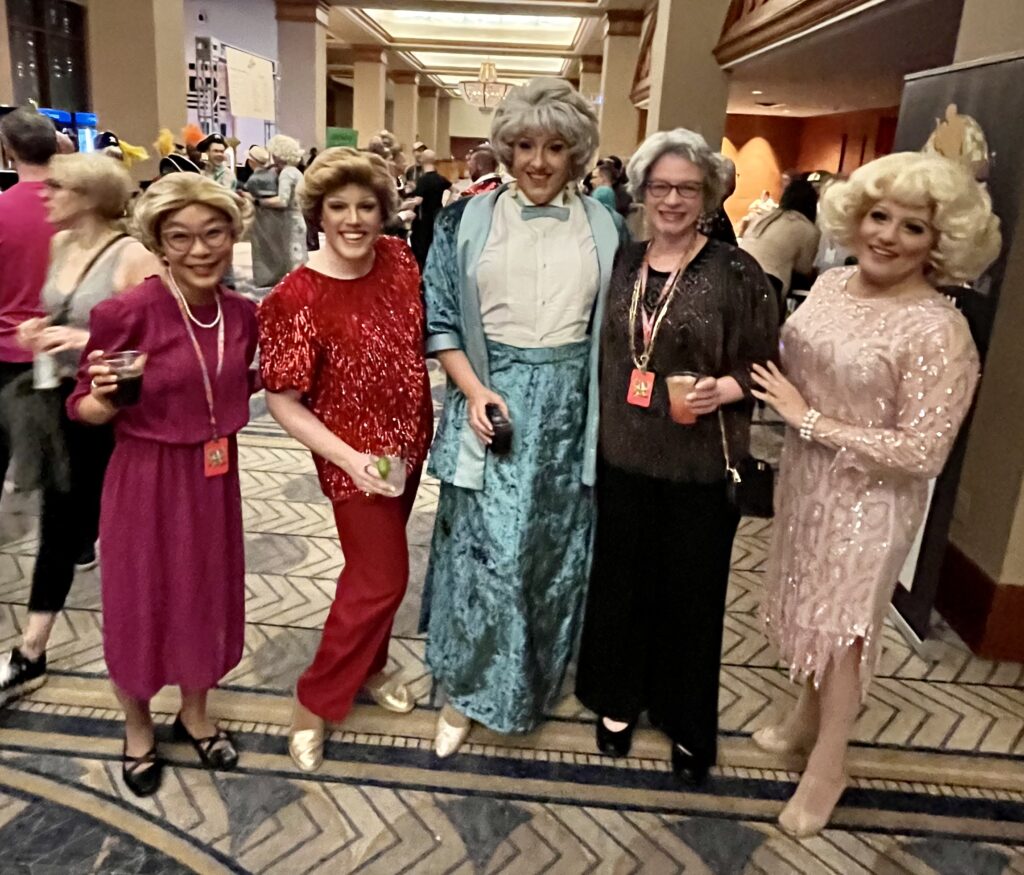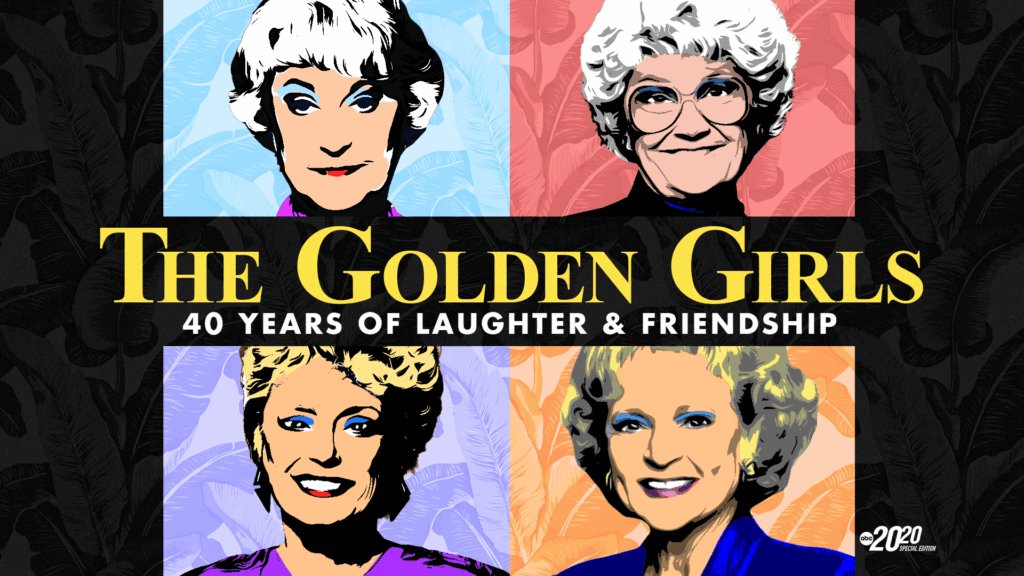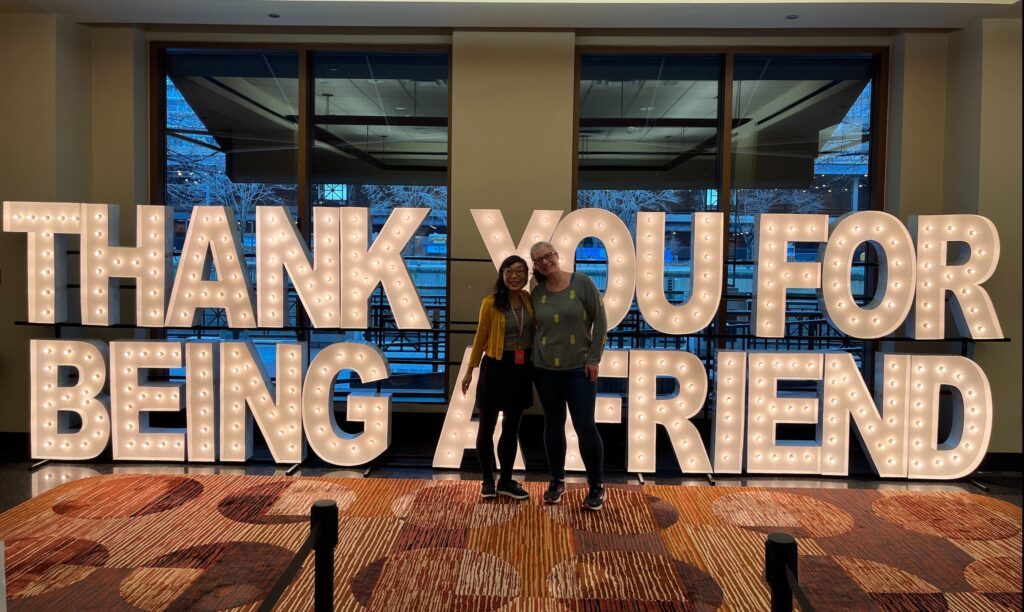The Longest Shortest Time
EPISODE #241: TV to Spark Conversations with Adolescent Kids
When Kristen Meinzer was a tween, she religiously watched The Golden Girls with her mom and grandma. The show helped her make sense of the world, bond with her matriarchs — and, later, to cope with their deaths.

Kristen (far left) at Golden Con, a convention for Golden Girls lovers
Now Kristen is a featured voice in ABC-HULU’s official 40th anniversary Golden Girls documentary!

Courtesy ABC-HULU
Tune in for Kristen’s thoughts on how the adult themes of The Golden Girls shaped her as a young person — and her recommendations for contemporary shows that have helped her spark fun and deep conversations with the adolescents in her life.
KRISTEN’S FULL LIST
We were unable to fit all of Kristen’s recommendations in the episode. Here’s her full list.
*Reality Competition Shows*
What it’s about: Teams of two go on a race around the world, completing challenges along the way – which include everything from mastering local dances to corralling local livestock.
Why to watch it with an adolescent: I love that the show teaches us about other parts of the world, while also showcasing the values of open-mindedness, trying one’s best, and cooperation. Truly, those who don’t cooperate with their partners are the ones who lose. Plus, it’s fun to choose teams to cheer for and ask fellow viewers “how would you do this challenge differently? which of us would be best at this task and why?”
What it’s about: A selection of talented drag queens compete in challenges to impress host RuPaul, the world’s most famous drag queen, with the hope of being crowned America’s Next Drag Superstar.
Why to watch it with an adolescent: RuPaul’s Drag Race takes the pettiness and drama of high school, turns it up to eleven, and allows us to cathartically choose sides, cheer, and be truly impressed. The show is good for a laugh, but it’s also great role-modeling for leaning into what makes us unique, and how to feel comfortable in our own skin.
What it’s about: Three families from modern times get transported to the western frontier to experience life as the pioneers did in the 1800s. This includes everything from using an outhouse to growing their own food.
Why to watch it with an adolescent: The show has a lot of humor, cooperation, and ingenuity – and it’s just plain fun to see how some of the things we take for granted end up in our lives – like butter or a mattress. But on top of that, it also explores how social roles and laws related to gender, sexual orientation, and race have changed over the years.
*Sit-Coms*
What it’s about: 15-year-old Devi is grieving the loss of her father, crushing on a boy who seems out of her league, and trying her best to improve her social status in high school after fumbling through a disastrous first year.
Why to watch it with an adolescent: I love how often Devi proves to be her own worst enemy, but still keeps trying. Who hasn’t been there? We all have. But somehow, magically, the show doesn’t make her the butt of the joke…they make her relatable, and hopefully help young viewers see “this thing that feels like the end of the world isn’t.” Plus, Devi has the best friends a gal could ask for…they love her without judgment, and we could all learn to do more of that.
What it’s about: Sabi, a non-binary twenty-something, tries to balance their roles as a child of Pakistani immigrant parents, a bartender at an LGBTQ bookstore and café, and a caregiver to the young children of a professional couple.
Why to watch it with an adolescent: Sabi is truly one of the kindest characters on television, while also being one of the most real. They grapple with trying to make others happy, while also being themselves. They have friends who love them, but fear not being accepted. They screw up and they survive screwing up. I think that’s important for everyone – especially teens – to see people mess up and move forward. Also, the show happens to be very funny and it’s probably the only one on my list that has a 100% fresh rating from Rotten Tomatoes.
What it’s about: Four very irritating, in some cases criminal, people find themselves in the afterlife – in what they’re told is “the good place” – but at least half of them suspect they were sent to this Heaven-esque place by accident, and attempt to avoid being found out and sent to the hell-like “Bad Place.”
Why to watch it with an adolescent: The show delves into complex ethical questions, like what it means to be a good person, the nature of right and wrong, and the importance of community. And, above all, it shows that we can all learn from our mistakes and do better.
What it’s about: In an imaginary future, a security robot gains free will and goes rogue, but in the process of creating his new life, he finds himself working for some very earnest astronauts who may drive him crazy with their kindness.
Why to watch it with an adolescent: Murderbot is socially awkward, has a hard time reading social cues, and is just starting to understand the many possibilities of what he might become. Not too different from what we all go through as we grow and evolve in life.
*Dramas*
What it’s about: A group of working class teens in a North Carolina beach town find a motel key hidden in a sunken ship…which leads to an envelope, a thick stack of money, and possible clues about one of their fathers, who has gone missing. Together, they follow the clues.
Why to watch it with an adolescent: For as long as there have been mysteries to solve, there have been kids solving them in fiction, and for good reason. Kids want to feel empowered. They want to be reassured that they are smart and can solve problems. They like the idea of teaming up with friends and saving the day. And Outer Banks offers a bit of this wish fulfillment in a package that feels a little more grown up than other teen-targeted shows.
What it’s about: After being kicked out of her latest school for retaliatory prank intended to defend her brother, Wednesday Adams is enrolled in Nevermore Academy, a private school for monstrous outcasts. Wednesday feels she doesn’t belong there…until she discovers she has inherited her mother’s psychic abilities, and might have the ability to solve a local murder.
Why to watch it with an adolescent: Sometimes – particularly during adolescence – we can feel like monsters. Our bodies and emotions and the world can feel out of control. But maybe we’re not really out of control. Maybe we’re actually special, and have powers no one can see? Of course we are and of course we do, and Wednesday is a kooky, relatable parable about that.
What it’s about: A group of twenty-something interns arrive at the fictional Seattle Grace Hospital to participate in their surgical residency program – where they learn how to save lives and in some cases make their own lives messier than they need to be.
Why to watch it with an adolescent: Many people – teens included – like procedurals. Episodes open with a mess. The mess is solved by the end. That kind of 44 minute fix can feel very soothing when the world doesn’t. Bonus: Grey’s Anatomy can be a great jumping off point for talking about certain bigger issues – about health, communication, and doing the right thing.

Kristen (left) at Golden Con, a convention for Golden Girls fans
More on Kristen Meinzer
Kristen has all kinds of amazing projects, which you can find at her website. Here’s a sampling:
• She’s a host of The Nightly, a pop culture bedtime podcast
• She’s the co-author of How to Be Fine: What We Learned from Living by the Rules of 50 Self-Help Books
• She’s also the cohost of the forthcoming My So Called Life rewatch series on Happy to Be Here, the podcast formerly known as Nerdette
The Longest Shortest Time may earn a small commission from products linked on this site. Using our affiliate links helps support our work.